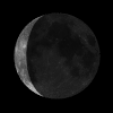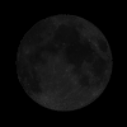
The Moon

Cold Enough for You?
The Full Moon of February is called the Superbowl Moon in modern
folklore.








Moon phases explained.
CURRENT MOON
As the Moon orbits the Earth in its elliptical orbit, it varies ts
distance, sometimes closer at perigee and sometimes farther
away at apogee. Here is a website that will calculate the times
of those events.

New Moon
The month of lunar phases starts
with the New Moon
But you cannot see the Moon at this time
unless it gets in front of the Sun and causes
a solar eclipse. Why don’t we get a solar
eclipse every month? The orbit of the Moon
is tilted out of the ecliptic enough so that the
Moon misses the Sun most of the time. There are only two times
each year, when the Moon passes through a node of its orbit, when an
eclipse is possible.
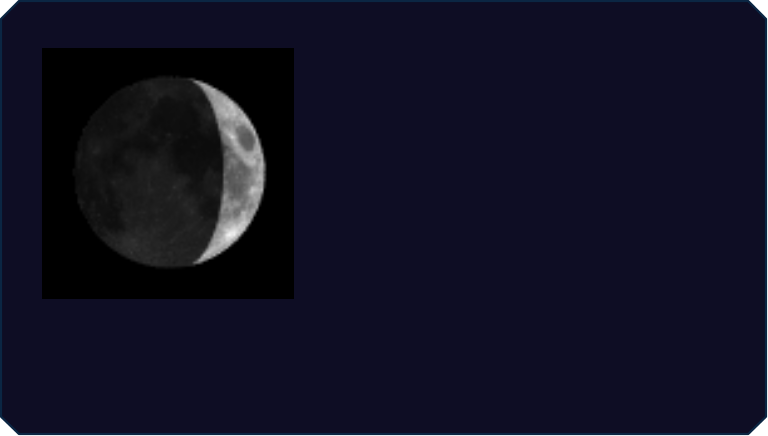
Waxing Crescent
This is the phase of the Moon that most
casual observers will see.
It hangs low in the western sky at sunset, when
people tend to be out and about in the early
evening. This is the phase most often drawn in
cartoons as well. Those drawings sometimes
take advantage of a bit of artistic license, by the
way. If drawn correctly for northern hemisphere observers, the Moon is
illuminated from the right, and the middle of the bright edge, or limb, is always
below the horizontal.

First Quarter
It is called a first quarter because the
Moon has moved one quarter of the way
around in its monthly cycle.
Most people would casually refer to this phase as
a ‘half moon’. It sits high in the south at sunset
and sets around midnight. Because of this, it is
also a phase of the Moon seen by many. During this phase of the Moon, the
rugged highlands of the southern regions of the Moon stand out in sharp relief.
My favorite trio of craters, Ptolemeus, Arzachel and Alphonsus are dramatically
lit. Watch this cool video and enjoy these three craters to the sound of the
blues.

Waxing Gibbous
This is the ‘almost Full’ Moon.
It is already above the horizon in the southeast as
the Sun sets. In the day or two before Full, it is
illuminated enough so that a casual observer
would interpret it as being Full. It spends most of
the night above the horizon and sets just a few
hours before sunrise.
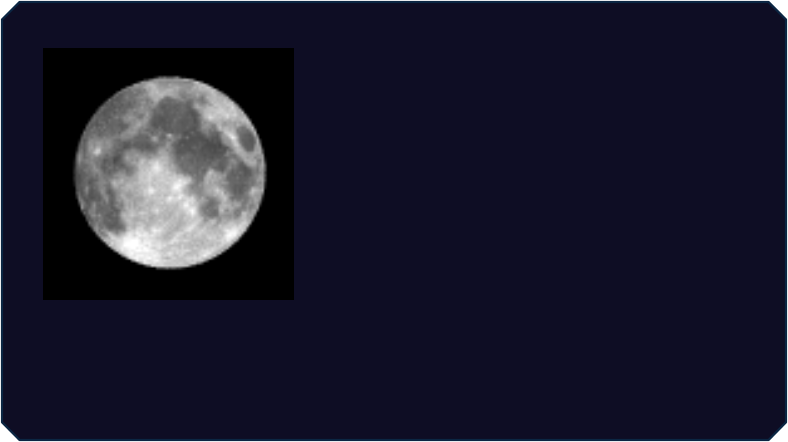
Full
What can we say about the Full Moon?
It permeates all of our cultural heritages. Think
about werewolves! In this phase, the Moon
opposes the Sun in every sense. It rises as the
Sun sets, and sets when the Sun rises. When it is
in that part of its orbit, there is always the chance
that it will find Earth’s shadow. It is then that we
might see a lunar eclipse. But we do not see an eclipse every Full Moon, of
course. The tilt of the Moon’s orbit causes it to miss our shadow most of the
time with lunar eclipses occurring once every six months or so.
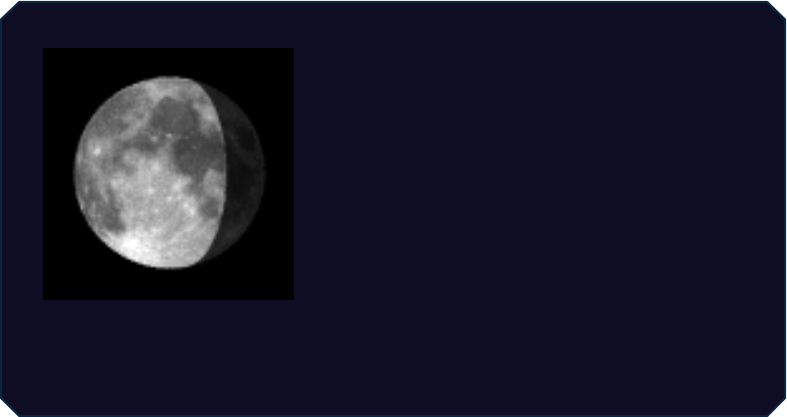
Waning Gibbous
This panel stretches horizontally and
vertically.
It often happens that observers will see this phase
in the west at dawn. This sometimes leads to
confusion as those unfamiliar with the workings of
the sky do not expect to see the Moon in the
daytime sky. What is true is that, roughly
speaking, the Moon is above the horizon for
twelve hours every day. Which twelve hours of the day those are depends on
the day of the month.
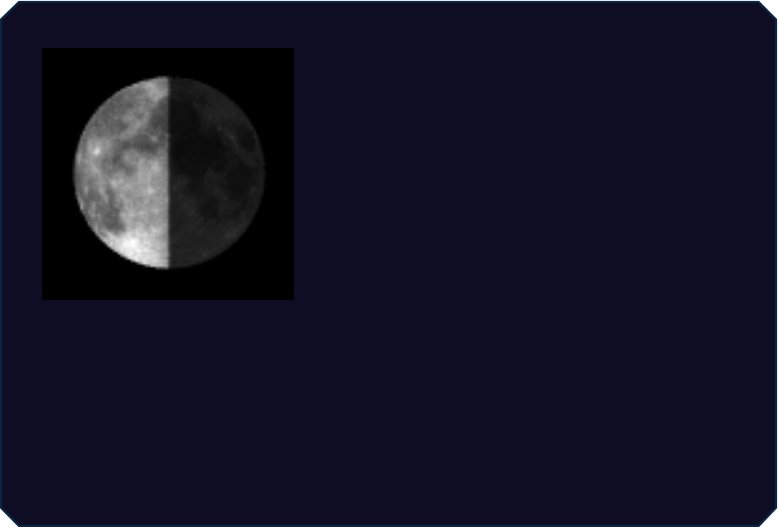
Third Quarter
This panel stretches horizontally and
vertically.
Amet officia irure sed. Eu in sint lorem
magna, ex ullamco dolor amet. Veniam
cillum esse eu, sed proident eu lorem
minim fugiat proident amet adipisicing
occaecat? Do id labore sed consectetur
deserunt incididunt. Minim do consequat, esse eu veniam ut
consectetur, ut lorem ut, commodo velit in. Aliqua irure ad eu qui
aliquip ea reprehenderit pariatur veniam voluptate. Quis officia
sint. Esse lorem ut esse dolor. Amet dolore tempor et irure non
fugiat.

Waning Crescent
The waning crescent Moon rises
just hours before sunrise.
This is the lunar phase that most
people miss, merely because they are
not interested in stargazing so early in
the morning as they have probably just woken up. The waning
crescent moon is particularly low on the eastern horizon in
early spring, due to the angle that the ecliptic makes with the
dawn horizon at that time of year. The best time to look for
this phase of the Moon would be late September.
The Moon









Moon phases explained.
As
the
Moon
orbits
the
Earth
in
its
elliptical
orbit,
it
varies
its
distance,
sometimes
closer
at
perigee
and
sometimes
farther
away
at
apogee.
Here
is
a
website
that
will
calculate
the
times
of those events.


New Moon
The month of lunar
phases starts with the
New Moon
But
you
cannot
see
the
Moon
at
this
time
unless
it
gets
in
front
of
the
Sun
and
causes
a solar eclipse.
Having just said that, why don’t we get a
solar eclipse every month? The orbit of the
Moon is tilted out of the ecliptic enough so
that the Moon misses the Sun most of the
time. There are only two times each year,
when the Moon passes through a node of
its orbit, when an eclipse is possible.

Waxing Crescent
This is the phase of the
Moon that most casual
observers will see.
It hangs low in the western
sky at sunset, when people
tend to be out and about in
the early evening. This is the phase most
often drawn in cartoons as well. Those
drawings sometimes take advantage of a bit
of artistic license, by the way. If drawn
correctly for northern hemisphere observers,
the Moon is illuminated from the right, and the
middle of the bright edge, or limb, is always
below the horizontal.
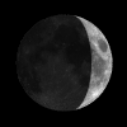


First Quarter
It is called a first quarter
because the Moon has
moved one quarter of the
way around in its monthly
cycle.
Many people might
casually refer to this phase as a ‘half moon’.
It sits high in the south at sunset and sets
around midnight. Because of this, it is also
the phase of the Moon seen by a majority of
part-time sky watchers. During this phase of
the Moon, the rugged highlands of the
southern regions of the Moon stand out in
sharp relief. My favorite trio of craters,
Ptolemeus, Arzachel and Alphonsus are
dramatically lit. Watch this cool video and
enjoy these three craters to the sound of the
blues.
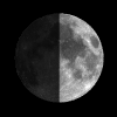

Waxing Gibbous
This is the ‘almost Full’
Moon.
It is already above the
horizon in the southeast
as the Sun sets. A day or
two before Full, it is
illuminated enough so that a casual
observer would interpret it as being Full. It
spends most of the night above the horizon
and sets just a few hours before sunrise.
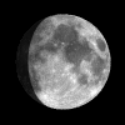

Full
What
can
we
say
about
the Full Moon?
It
permeates
all
of
our
cultural
heritages.
Think
about
werewolves
!
In
this
phase,
the
Moon
opposes
the
Sun
in
every
sense.
It
rises
as
the
Sun
sets,
and
sets
when
the
Sun
rises.
When
it
is
in
that
part
of
its
orbit,
there
is
always
the
chance
that
it
will
find
Earth’s
shadow.
It
is
then
that
we
might
see
a
lunar
eclipse.
But
we
do
not
see
an
eclipse
every
Full
Moon,
of
course.
The
tilt
of
the
Moon’s
orbit
causes
it
to
miss
our
shadow
most
of
the
time
with
lunar
eclipses
occurring
once
every
six
months
or so.
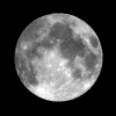

Waning Gibbous
It
often
happens
that
observers
will
see
this
phase
in
the
west
at
dawn.
This
sometimes
leads
to
confusion
as
those
unfamiliar
with
the
workings
of
the
sky
do
not
expect
to
see
the
Moon
in
the
daytime
sky.
What
is
true
is
that,
roughly
speaking,
the
Moon
is
above
the
horizon
for
twelve
hours
every
day.
Which
twelve
hours
of
the
day
those
are depends on the day of the month.
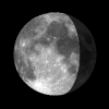

Third Quarter
This phase of the Moon is
not often observed owing
to the fact that it rises at
midnight and sets at
noon. Casual observers
might spot it in the south
just before sunrise, but not many of us are
skyatching at 5 AM!
One notable thing about this phase is that
it allows telescopic observers to see the
Sun setting on the southern crater Tycho.
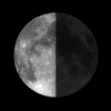

Waning Crescent
The
waning
crescent
Moon
rises
just
hours
before
sunrise.
This
is
the
other
lunar
phase,
(
other
than
third
quarter
),
that
most
people
miss,
merely
because
they
are
not
interested
in
stargazing
so
early
in
the
morning
as
they
have
probably
just
woken
up.
The
waning
crescent
moon
is
particularly
low
on
the
eastern
horizon
in
early
spring,
due
to
the
angle
that
the
ecliptic
makes
with
the
dawn
horizon
at
that
time
of
year.
The
best
time
to
look
for
this
phase
of
the
Moon
would
be
late
September.
